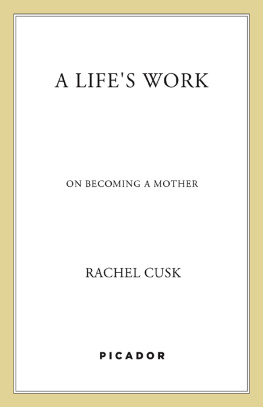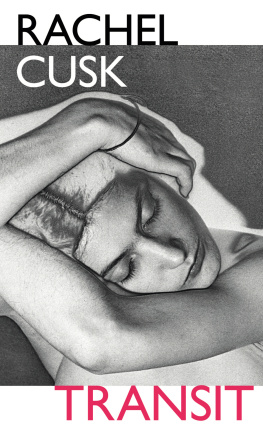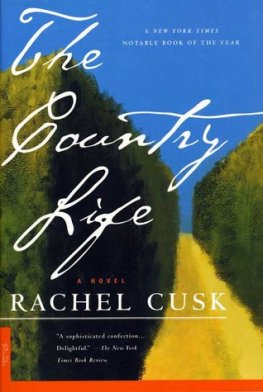The author and publisher have provided this e-book to you for your personal use only. You may not make this e-book publicly available in any way. Copyright infringement is against the law. If you believe the copy of this e-book you are reading infringes on the authors copyright, please notify the publisher at: us.macmillanusa.com/piracy.
Where I live, there is always someone driving slowly on the road ahead. This is in the countryside by the sea and the roads are narrow and burrow-like, with high hedges either side to protect the fields from the coastal winds. The roads are digressive in character, rarely travelling directly to a specific location. They branch across the flat fields like veins. It is hard to see whats coming, and since there arent many vantage points its easy to get lost. Still, its nothing that requires excessive caution. Theres no particular reason for alarm, in fact quite the reverse. Yet people drive at fifteen, twenty, thirty miles an hour. No matter how many of them you get past, theres always another one around the next bend.
A large proportion of these drivers are elderly: their cars are often immaculate and new. At certain seasons there are also many tourists, attempting to manoeuvre their caravans and motorhomes along the winding narrow lanes. There are farms here, and so it is sometimes tractors that block the road, their big churning wheels flinging clods of mud behind them that spatter across your windscreen or land thudding on the car roof. There are stretches where the road briefly straightens so that you can see far enough to overtake. People in big, powerful cars do this boldly and calmly and as though insensible to risk. Others hesitate and miss their chance. But no matter how many times you overtake, within a few minutes you will be stuck behind someone else.
This is a rural area, a backwater, and so it could be assumed that people here are rarely in much of a hurry. Alternatively, it could be said that the relative isolation of our lives can make us less aware of others and of the spaces we share. The coast road is the local thoroughfare: it is usually necessary to take it, to get nearly anywhere you might need to go. It passes through numerous villages whose architecture of narrow bridges and constricted high streets, though scenic, presents many obstacles to the flow of traffic. Problems are constantly arising, and though it could not be said to be the fault of these quaint places, they take on something of the character of an obstacle course when large numbers of vehicles are trying to pass through them. The houses and cottages here are old and have remained the same size, while the vehicles that pass them have become larger: sometimes the cars are no more than two or three feet from their windows. When the traffic is at a standstill, some of the smaller cottages look dwarfed by the cars. It is possible for the people in the cottages and the cars to look at one another.
Several times a day the road through a village will be backed up both ways with stationary traffic, so that it can seem as though there is some calamity or attraction there. Yet it is only the spectacle of people trying to do what they want where it is impossible, for the reason that the vehicles are much bigger and more unwieldy than the humans inside them. At the centre of the jam you will often find, for instance, a giant motorhome and a delivery lorry face to face, unable to get past one another on the narrow village street. This situation can sometimes have no solution other than for one whole line of cars to reverse out of the village to allow the other to pass. If there is no one available to suggest and oversee this operation, the impasse can last a long time. But usually someone assumes the position of authority. Trying to unravel these snarl-ups, it often becomes clear that many of its participants are unable fully to manoeuvre and control the cars they are driving. Others struggle to adapt to the change of circumstance and to the necessity for acting as a group. Passing such a situation on foot, the sight of the rows of human faces trapped behind and framed by their windscreens can be especially striking, as though a portrait-painter had drawn them.
On the open road, the slow drivers often fail effectively to communicate their intentions and aims. They will brake for no perceptible reason on a straight and empty stretch, or lose speed until they come inexplicably to a halt, presumably unaware that there is anyone behind them. If they signal, they do it too late in the build-up to an action; often it is a case of working out what they are doing or mean to do by reading their driving behaviour. A person who slows down at every junction or side road, for example, can be guessed to be looking for a turning but unsure of where it is. Others will brake suddenly when they pass a pub or a shop, evidently considering going in. The usual autonomy and separation of the car, its hermeticism, is reversed: the responsibility of driving, its visual and mental burden, is passed to those outside it. This being a backwater, as well as a place for holidaymakers, it may be the case that people feel entitled to shed that burden here. In this remote place the distinction between private and public worlds is less clear; the contract of the road, its status as a sphere of regulation by agreement, breaks down. Yet there are others for whom this suggestion of lawlessness is the catalyst for signalling their intentions too zealously. They drive as it were sanctimoniously, as though to teach the rest of us a lesson. If they are going to make a right turn, they do it with a great fanfare of long-drawn-out indicating and braking. They obey the rules of the road so deliberately and self-consciously that their behaviour becomes distracting, like actors threatening the integrity of a crowd scene by continually drawing attention to themselves and to the role they are being expected to play. It is as though, for them, the road is not a shared reality but a kind of fiction, an opportunity to become visible through disguise.
I have often heard it suggested that elderly citizens should not drive, and that is certainly a consideration where I live. A few years ago a woman of ninety-four killed a girl of ten at a pedestrian crossing. There have doubtless been a number of such incidents, but this one has stayed in my mind. One reason, I suppose, has to do with narrative, with the fact that the meaning of this womans life was entirely altered by a single event at its end: this is not how stories generally work. Since she had already lived an unusually long life I wondered whether the woman wished she had died before killing the girl, but the question of who is responsible in that situation appears somewhat opaque. One might see the car as a weapon lawfully placed in the drivers hands, in which case a woman of that age ought perhaps to have decided not to drive it; or one might see the laws that leave that decision to her as murderous. The car itself could be viewed as the murderer, since its capacity for destruction is so tenuously linked to that of the person driving it.
The reason most often given by the elderly for continuing to drive is the wish to retain their independence. Without a car, in other words, they would become subject to and entrapped by the reality of their own lives. There are many others for whom this is also the case, people whose arrangements whether through force of circumstance or as a result of the choices theyve made would be made untenable by having no car. This is a rural area where few services are reachable on foot, so most of the people who live here fall into that category. To have no car, around here, is to be the victim of circumstance.















